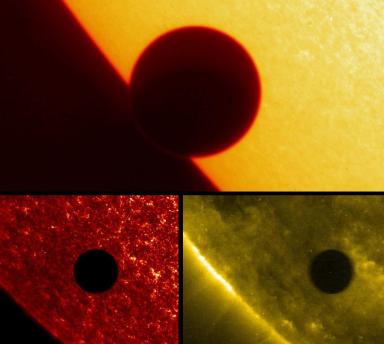 This June, Venus is going to make a rare transit across the disk of the sun as observed from Earth. Transits of Venus are rare. They come in pairs eight years apart, but each pair is separated by 105.5 years or 125.5 years. The upcoming transit is the pair to one that occurred in 2004, so if you miss this one you won’t have a chance to see another until 2117. (Left, three views of the 2004 transit.)
This June, Venus is going to make a rare transit across the disk of the sun as observed from Earth. Transits of Venus are rare. They come in pairs eight years apart, but each pair is separated by 105.5 years or 125.5 years. The upcoming transit is the pair to one that occurred in 2004, so if you miss this one you won’t have a chance to see another until 2117. (Left, three views of the 2004 transit.)
Since it’s highly unadvisable to look directly at the sun, watching a transit is best done with protective eye gear or by looking at the sunlight reflected off something. That’s what the Hubble Space Telescope is going to do. Like us, Hubble can’t look directly at the sun, so its going to observe the transit of Venus by measuring the light reflected off the Moon. It’s an amazing method, and the observations Hubble makes will go towards answering questions about our planet and our place in the Universe. Read the full story about Hubble’s plans for the transit of Venus at Discovery News.










